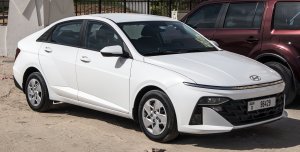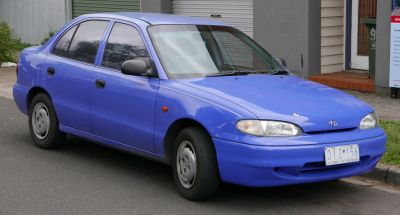Hyundai Accent

- Year: 1994
- Status: in_production
- Also Called:
- Hyundai Verna
The Hyundai Accent is a subcompact car known for its affordability, fuel efficiency, and surprisingly roomy interior. Targeting budget-conscious buyers, the Accent provides a practical and reliable means of transportation without breaking the bank. While not boasting luxurious features, it offers a comfortable ride for its class, often praised for its surprisingly spacious cabin relative to its external dimensions. Its smaller engine size contributes to excellent fuel economy, a significant advantage in today’s market. Modern Accent models include updated safety features, although the level of technology might be less extensive compared to higher-priced competitors. The Accent's strong value proposition makes it a popular choice for first-time car buyers or those seeking an economical and reliable vehicle.
Generations
First generation (X3; 1994)
The first generation Hyundai Accent (X3, 1994-1999) represented Hyundai's initial foray into the subcompact car market. This generation was a simple, no-frills vehicle primarily designed for affordability and practicality. Its boxy design was functional rather than stylish, reflecting the economic car market trend of the time. The Accent X3 relied on smaller, less powerful engines but offered good fuel economy, a key selling point for budget-conscious consumers. Features were basic, with the focus squarely on dependability and reliability rather than luxury or advanced technology. Despite its rudimentary design and features, the Accent X3 proved remarkably successful, building a reputation for durability and providing a solid entry point into the Hyundai brand.
Second generation (LC; 1999)
The second generation Hyundai Accent (LC, 1999-2005) marked a significant evolution from its predecessor. While still prioritizing affordability, this generation exhibited a more refined design with smoother lines and a more contemporary aesthetic. This involved increasing the overall size and offering more interior room. The engine options were updated for slightly more power and improved fuel economy. The interior quality was also improved compared to the first generation, offering a more comfortable and modern driving experience. While still a budget-oriented car, the second-generation Accent made strides in improving its design, build quality, and features, attracting a wider range of buyers who valued a more polished and refined subcompact car. It also benefited from the improving reputation of Hyundai itself.
Third generation (MC; 2005)
The Hyundai Accent's third generation (MC, 2005-2010) represented a significant leap forward for the subcompact model. This iteration, built on a new platform, offered improved styling with more rounded edges compared to its predecessor, a more spacious interior, and enhanced safety features. While still predominantly powered by economical four-cylinder engines, the MC Accent saw improvements in fuel efficiency and performance. Available in sedan and hatchback body styles, it continued to target budget-conscious buyers seeking reliable and practical transportation, while also attempting to project a more refined image than earlier Accents. The increased interior space and improved ride quality were key selling points, addressing some of the criticisms leveled against the second generation. Though not groundbreaking in terms of technology, the MC Accent served as a solid base for Hyundai's continued growth in the global market.
Fourth generation (RB/RC; 2010)
The Hyundai Accent's fourth generation (RB/RC, 2010-2017) marked a substantial evolution, emphasizing a more mature and contemporary design. Building upon the successes of the previous generation, this Accent boasted a noticeably more sophisticated exterior, incorporating fluid lines and a more aerodynamic profile. Engine options remained primarily focused on fuel efficiency, with upgrades resulting in improved power output and better mileage. Safety features were further enhanced, with several models offering stability control and multiple airbags as standard. This generation witnessed the introduction of more advanced technological features, slowly moving the Accent away from its purely budget-oriented image. The availability of different trim levels catered to a broader range of customer preferences, allowing for a more customized experience. Interior space also saw improvement, offering a more comfortable ride, especially for rear passengers.
Fifth generation (HC/YC; 2017)
The Hyundai Accent's fifth generation (HC/YC, 2017-2023) showcased a significant design departure, adopting a more aggressive and sporty aesthetic. This generation showcased Hyundai's evolving design language, characterized by its sharper lines and a more dynamic stance. The focus on fuel efficiency remained, but this time it was complemented by a marked improvement in overall driving dynamics. The addition of more advanced safety technologies, including autonomous emergency braking and lane departure warning, cemented its position as a safer and more technologically advanced option in its segment. This generation also saw improvements in interior materials and build quality, further enhancing the overall perceived value. The focus on refinement and driving experience marked a clear progression from its budget-conscious roots while retaining its core value proposition of affordability and efficiency.
Sixth generation (BN7; 2023)
The Hyundai Accent's sixth generation (BN7, 2023-present) represents a further refinement of the model's design and technology. While maintaining its compact dimensions, this generation emphasizes a more modern and sophisticated look, building on the styling cues established by its predecessor. This iteration integrates the latest safety and driver-assistance features, including advanced driver-assistance systems (ADAS) reflecting current technological advancements in the automotive industry. The focus on fuel efficiency continues, but with an emphasis on improving performance and refinement. While specifics vary by region, this generation typically features improved infotainment systems and interior upgrades, aiming to provide a more premium and technologically advanced driving experience. Hyundai aims to further solidify its position in the competitive subcompact segment with a blend of affordability, efficiency, and improved overall refinement.
